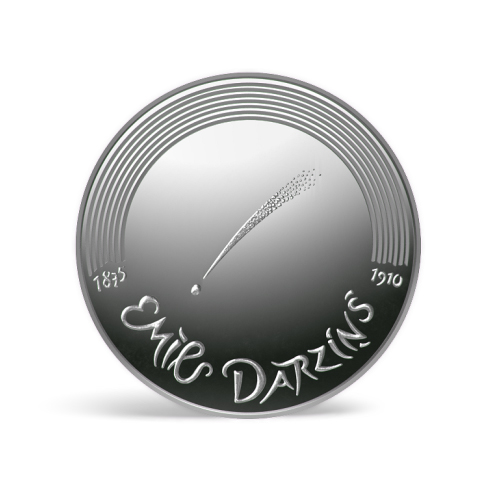
E-mail: coins@bank.lv
Cashier's Office in Riga
Address: Bezdelīgu 3, Rīga
Phone: +371 67022722
 Kolekcijas
KolekcijasSelect your language


Obverse
The obverse design depicts a radiant shooting star. At the top, it is half-circled by seven concentric bands of an arc representing a rainbow, with the year 1875 (birth of Emīls Dārziņš) at the left end and 1910 (death of Emīls Dārziņš) at the right end of the arc. The bottom part bears the semi-circled inscription EMĪLS DĀRZIŅŠ.
Reverse
The reverse design features the inscription VALSE MÉLANCOLIQUE, with the year 2015 on the right and a slantwise inscription 5 EURO at the bottom.
Edge
The edge bears the inscriptions LATVIJAS BANKA and LATVIJAS REPUBLIKA, separated by rhombic dots.
Specifications
Face value: 5 euro
Weight: 22.00 g
Diameter: 35.00 mm
Metal: silver of fineness .925
Quality: proof
Maximum mintage: 5 000
Struck in 2015 by Koninklijke Nederlandse Munt (the Netherlands)
Artists Graphic design: Ilmārs Blumbergs
Plaster model: Jānis Strupulis
Emīls Dārziņš (1875–1910) personifies the soul of Latvian classical music. He lived to be only 34, had a very talented son, composed 17 choir songs, 19 solo songs (one was destroyed, another one lost), four compositions for symphony orchestra (three destroyed), two fragments for an unfinished opera, wrote reviews and descriptions, and ended up dying a mysterious death on railroad tracks.
Along with simple, non-pretentious compositions, Dārziņš' oeuvre contains opuses of great symbolic power. Choir music is unthinkable without the majestic "Lauztās priedes" ("Broken Pines"), the serenity of "Mēness starus stīgo" ("Radiant Moon Rays"), the flow of "Senatne" ("Yesteryear"), the tragic "Ciānas bērni" ("The Children of Zion") and the radiant "Sapņu tālumā" ("In Distant Dreams"). Beauty is born when the men's choir sings "Mirdzi kā zvaigzne" ("Shine Like a Star"), "Nāc man līdz!" ("Come with Me!"), "Mūžam zili" ("Forests Forever Blue"), "Es zinu" ("I Know"). The world of solo songs will always include "Aizver actiņas un smaidi" ("Close Your Eyes and Smile"), "Pazudusī laimīte" ("Lost Happiness"), "Teici to stundu, to brīdi" ("Tell Me That Hour"), "Vēl tu rozes plūc" ("Still You Pick Roses"), "Kā zagšus" ("Quietly") and others.
Yet "Valse Mélancolique", to which the collector coin issued by Latvijas Banka is dedicated, stands above all else. After false accusations for plagiarism, Dārziņš destroyed all of his symphony scores, with only "Valse Mélancolique" miraculously escaping this fate. One time, sitting in the dusk in writer Jānis Poruks' garden, Dārziņš had a vision of a white, dreamlike apparition of Our Lady, which became the impulse for the creation of "Valse Mélancolique". The gentle, rolling melody becomes even more melancholy in the solo part for the clarinet. Even in our day and age, when overplayed merriment and optimism seem to be required in human interaction, "Valse Mélancolique" allows us at least to be quiet, if not sad, for a moment.
Poet Jānis Sudrabkalns has described the composition as follows: "It would seem that there could be no simpler and more crystal clear work than this. Yet it is also sophisticated in its multifaceted sparkle. There is the sunny and melancholy southern breeze; the blue autumn shadows blooming in the mist; the quiet wings of thought in the middle part .. and the dying rhythm of the soul, but amongst it all, there seem to be the silvery cobwebs of fall fields, which require fine control."
Emīls Dārziņš was a trailblazer in music criticism and essays. His style was tactful, finely wrought, apt and sometimes pointed. He was among the first to write about Jāzeps Vītols, Alfrēds Kalniņš and the Song Festival; he also wrote an essay in commemoration of Mozart and discussed the history of the opera.
From withering irony to silvery dreaminess – that was the scope of Dārziņš' spirit whose impact we still feel today. His life was short and was hardly spent in luxury; he had a passionate love of music and was a lonely spirit. Dārziņš' work was continued by his son, the outstanding composer and music critic Volfgangs Dārziņš.
